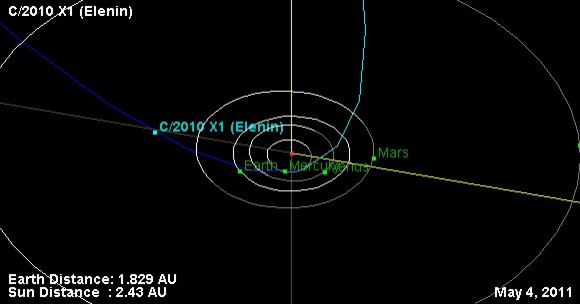Doomsday Comet Elenin Zips Past Dangerously Close to Earth
Comet Passed Only 22 Million Miles From Earth

You may have heard the news: Comet Elenin passed by Earth early Sunday morning. Comet Elenin (also known by its astronomical name C/2010 X1), was first detected on Dec. 10, 2010 by Leonid Elenin, an observer in Lyubertsy, Russia, who made the discovery remotely using the ISON-NM observatory near Mayhill, New Mexico. At the time of the discovery, the comet was about 647 million kilometers (401 million miles) from Earth. Since January, the comet - as comets do - closed the distance to Earth's vicinity as it made its way closer to perihelion (its closest point to the sun).
That is what happens with these long-period comets that come in from way outside our planetary system, Don Yeomans of NASA's Near-Earth Object Program Office at NASA's Jet Propulsion Laboratory in Pasadena, Calif. said.
They make these long, majestic, speedy arcs through our solar system, and sometimes they put on a great show. But not Elenin. Right now that comet looks kind of wimpy.
How does a NASA scientist define cometary wimpiness?
We're talking about how a comet looks as it safely flies past us, said Yeomans.
Some cometary visitors arriving from beyond the planetary region - like Hale-Bopp in 1997 -- have really lit up the night sky where you can see them easily with the naked eye as they safely transit the inner-solar system. Comet Elenin will not encounter any dark bodies that could perturb its orbit, nor will it influence us in any way here on Earth. Comet Elenin will not only be far away, it is also on the small side for comets. And comets are not the most densely-packed objects out there. They usually have the density of something akin to loosely packed icy dirt.
Yeomans did have one final thought on comet Elenin.
This intrepid little traveler will offer astronomers a chance to study a relatively young comet that came here from well beyond our solar system's planetary region. After a short while, it will be headed back out again, and we will not see or hear from Elenin for thousands of years. That's pretty cool.
NASA detects, tracks and characterizes asteroids and comets passing relatively close to Earth using both ground- and space-based telescopes. The Near-Earth Object Observations Program, commonly called Spaceguard, discovers these objects, characterizes a subset of them, and predicts their paths to determine if any could be potentially hazardous to our planet.
© Copyright IBTimes 2025. All rights reserved.





















